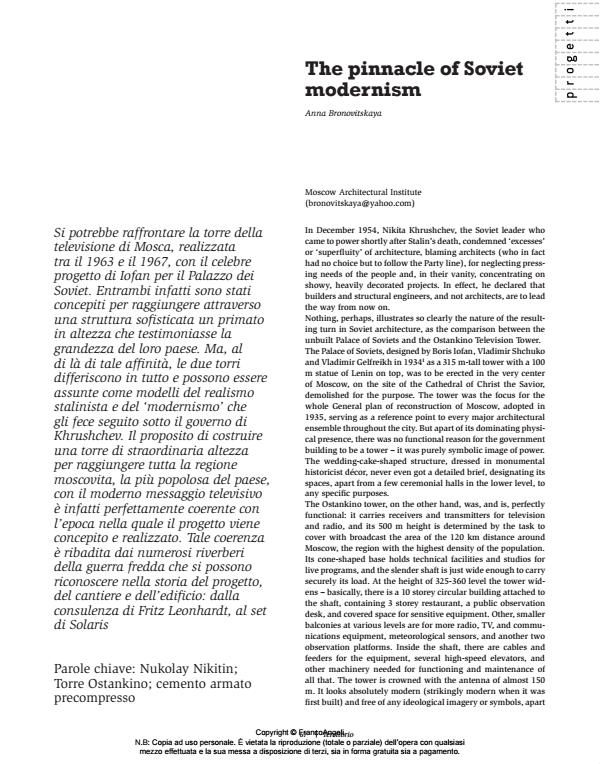The pinnacle of Soviet modernism
Titolo Rivista TERRITORIO
Autori/Curatori Anna Bronovitskaya
Anno di pubblicazione 2014 Fascicolo 2013/67
Lingua Inglese Numero pagine 5 P. 67-71 Dimensione file 746 KB
DOI 10.3280/TR2013-067011
Il DOI è il codice a barre della proprietà intellettuale: per saperne di più
clicca qui
Qui sotto puoi vedere in anteprima la prima pagina di questo articolo.
Se questo articolo ti interessa, lo puoi acquistare (e scaricare in formato pdf) seguendo le facili indicazioni per acquistare il download credit. Acquista Download Credits per scaricare questo Articolo in formato PDF

FrancoAngeli è membro della Publishers International Linking Association, Inc (PILA)associazione indipendente e non profit per facilitare (attraverso i servizi tecnologici implementati da CrossRef.org) l’accesso degli studiosi ai contenuti digitali nelle pubblicazioni professionali e scientifiche
The Moscow television tower, built between 1963 and 1967, could be compared with Iofan’s famous design for the Palace of Soviets. Both were in fact conceived in order to achieve, by means of a sophisticated structure, a record height to bear witness to the greatness of their country. However, apart from that similarity, the two towers are completely different and can be taken as models of Stalinist realism and of the ‘modernism’ which followed it under Khrushchev’s rule. The intention to build a town of extraordinary height in order to reach the whole of the Muscovite region, the most populous in the country, with modern television messages was in fact perfectly consistent with the period in which the design was conceived of and implemented. This consistency is borne out by the numerous echoes of the cold war, which can be seen in the history of the design, the construction site and the building: ranging from Fritz Leonhardt’s consulting services to the Solaris film set.
Parole chiave:Nukolay Nikitin; Ostankino Tower; prestressed reinforced concrete
- Dykhovichny Yu.A., 1973, «N.V.Nikitin-inzhener, ucheny, issledovatel», Beton i zhelesobeton, n. 10.
- Dykhovichny Yu.A., 1977, N.V.Nikitin. Zhizn’ i tvorchestvo, Stroyizdat, Moskva.
- Grif A.Ya., 1975, Vysochayshaya televizionnaya bashnya, Svyazizdat, Moskva.
- Ikonnikov A.V., 1984, Architektura Moskvy, Moskovskij Rabočij, Moskva.
- Mikhailov A., 1968, «Leninsky plan monumentalnoy propagandy i arkhitektura », Arkhitektura Sssr, n. 8, pp. 3-13.
- Nikitin N.V., 1972, Ostankinskaya televizionnaya bashnya, Stroyizdat, Moskva.
Anna Bronovitskaya, The pinnacle of Soviet modernism in "TERRITORIO" 67/2013, pp 67-71, DOI: 10.3280/TR2013-067011